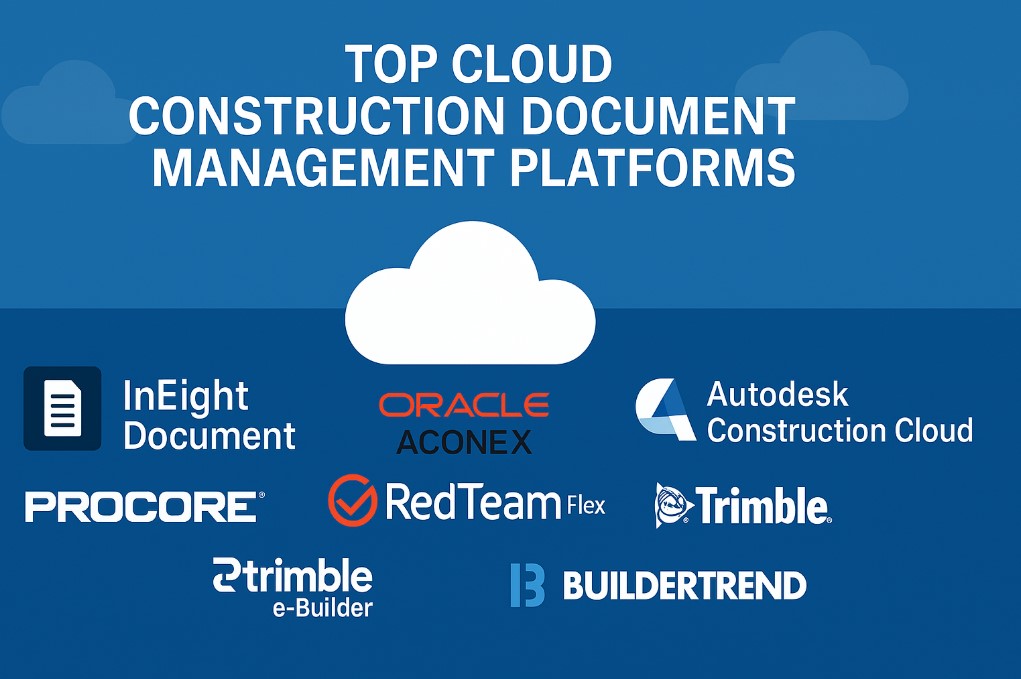Top Cloud Construction Document Management Platforms Ranked for Upcoming Projects
The article ranks the top cloud-based construction document management platforms, focusing on features like security, mobile access, collaboration, and scalability. It provides insights for choosing the right platform based on project size, security needs, and integrations.
Paper blueprints are fading fast. In 2023, cloud construction document management platforms pulled in about $2.1 billion, and analysts expect the market to hit $5.8 billion by 2033. One outdated plan can still wreck a schedule, blow a budget, and dent your reputation, so teams now demand a single, secure source of truth that syncs from the architect’s desktop to the field crew’s phone. In this guide, we’ll rank the best cloud solutions for projects and unpack our scoring criteria—so you can choose the right platform with confidence.
How we evaluated the contenders
We built a six-point scorecard around the biggest drivers of construction rework and delay.
-
Single source of truth: According to PlanRadar, miscommunication and bad data cause up to 26 percent of all rework on U.S. projects, so every document had to live in a secure cloud hub with version history, audit trails, and role-based permissions.
-
Mobile and Offline Access: Research from S&W Marketing shows that 82 percent of contractors already capture field data on mobile apps. Platforms scored higher when they offered full-featured iOS and Android apps, tablet layouts, and reliable offline sync for remote sites.
-
Collaboration Workflows: We looked for real-time markups, threaded comments, and no-code workflows for RFIs, submittals, and change orders, because email loops still create costly lag.
-
Open Integrations: Drawings connect to estimating, scheduling, BIM, and accounting, so we favored open APIs and plug-and-play connectors that keep data moving between systems.
-
Security and Compliance: FedRAMP readiness, ISO 19650 alignment, and encryption in transit and at rest were non-negotiable to protect sensitive project data.
-
Proven Market Fit: We skipped tools without U.S. support, construction-specific design, or live builds over five million dollars, so each pick can grow with your project size and risk profile.
Quick-glance comparison table
You rarely have hours to scan spec sheets, so we distilled the essentials into one quick-look grid. Treat the figures as ballpark list pricing; enterprise deals often vary.
| Platform | Core target user | Unlimited storage | Security / Compliance | Key Integrations |
| InEight Document | Mega-project owners and EPCs | Yes | FedRAMP Ready | Oracle P6, SAP |
| Oracle Aconex | Infrastructure and JV mega-projects | Yes | ISO 19650–aligned CDE | Primavera, BIM 360 |
| Autodesk Construction Cloud Docs | BIM-centric design-build teams | Nearly unlimited | SOC 2 + Autodesk SSO | Revit, Civil 3D |
| Procore | Large GCs and CMs | Yes | SOC 2 Type II | 400+ marketplace apps |
| RedTeam Flex | Mid-market commercial GCs | Yes | MFA + audit log | QuickBooks, Sage 300 |
| Trimble e-Builder | Public and private owners | Yes | SSAE-18, SSO | Viewpoint, Power BI |
| Buildertrend | Residential & light-commercial builders | Yes | Role-based permissions | QuickBooks, Xero |
Enterprise-scale common data environments
On megaprojects, a single bad drawing can snowball into rework that eats five to ten percent of total project cost. To minimize that risk, we scored enterprise platforms on five weighted factors: security, unlimited scale, workflow control, BIM tools handling, and field usability. Three systems came out on top.
1. InEight: best-in-class security and configurability
InEight is the only construction CDE with FedRAMP Ready status, meeting 325 federal security controls. Every file action stays in a permanent log, and admins can model anything from a five-step design review to a two-step RFI loop. Billion-dollar infrastructure teams report managing millions of documents without performance hits. Unlimited storage, offline mobile sync, and an open API for Oracle P6 connected to the wider tech stack.
2. Oracle Aconex: unlimited scale for mega-projects
Oracle Aconex gives each company its own walled-off workspace while linking everyone through a single data lake. The platform can, according to Oracle’s help site, “manage millions of documents and models without limits on data or participants,” so joint ventures never juggle seat counts. ISO 19650 alignment, metadata-rich search, and a built-in Mail module keep every commitment traceable across continents.
3. Autodesk Construction Cloud Docs: gold standard for BIM workflows
Autodesk reports that more than 350,000 projects worldwide rely on Autodesk Construction Cloud for document and model coordination. In Docs, designers publish sheets from Revit or Civil 3D straight into the cloud, and field crews open the same files minutes later in a browser viewer. Automated versioning flags outdated plans before steel is cut, and detailed mark-ups keep clashes out of the field. While storage and seats depend on Autodesk licensing, no platform links design and construction data more tightly.
Mid-market all-in-one suites
Commercial GCs with annual revenue in the tens or low hundreds of millions still need enterprise muscle but not the seven-figure price tag. Two cloud suites dominate that sweet spot.
1. Procore: familiar powerhouse, now topping one million users
Procore reports that more than one million construction professionals log in to the platform on about 90,000 active projects worldwide. Unlimited user licenses let every subcontractor join without seat negotiations.
If you're looking for a full-service solution to manage all aspects of your construction project, be sure to explore our Construction Project Management Software category for additional tools and comparisons.
Key wins:
-
Connected modules: Documents sit next to schedule, quality, safety, and cost tools, so a markup on Sheet A1.01 can become a change-order line in seconds.
-
Field-first design: Supers snap photos or answer RFIs on mobile, and updates sync right back to the office.
-
Ecosystem depth: The App Marketplace lists around 120 integrations, and the company says about 75 percent of customers install at least one to handle drones, payroll, or BI dashboards.
If you want full-suite rigor without extra red tape, Procore gives your team a proven, cloud-first backbone.
2. RedTeam: enterprise features on a mid-market budget
RedTeam Flex covers CRM, estimating, contracts, daily logs, and change orders, yet list pricing starts at $729 per month for up to five million dollars in active project value.
Stand-out traits:
-
Contract control: Draft, route, and e-sign agreements; each revision is time-stamped and searchable.
-
AI-assisted submittals: Upload a spec book, and RedTeam builds a submittal register in minutes, then tracks ball-in-court responsibility.
-
Tight accounting loop: Native connectors to QuickBooks and Sage push field costs straight into the general ledger, cutting month-end crunch.
For contractors moving beyond spreadsheets yet wary of enterprise quotes, RedTeam offers disciplined project control at a sensible price.
Owner-centric program control (Trimble Unity Construct, formerly e-Builder)
Capital-program owners often juggle dozens or even hundreds of active builds at once. Trimble says that Unity Construct, rebranded from e-Builder in 2025, helps more than 200,000 projects worth about $300 billion stay on time and on budget.
Why owners choose Unity Construct:
-
Centralized document vault: Drawings, contracts, and studies live beside budgets and schedules, so no one hunts through folders. Role-based permissions let architects edit, contractors upload, and executives view.
-
Hands-free workflows: Change orders, pay apps, and RFIs route themselves, stamping dates and dollar impacts so you’re audit-ready.
-
Portfolio dashboards: KPIs from ten hospital builds or fifty retail rollouts roll into one screen; click a red CPI and you drill to the exact invoice PDF.
-
Enterprise-level security: SSAE-18 hosting, SSO, and MFA guard sensitive owner data, and immutable logs capture every approval.
If you need board-level clarity without losing project-level detail, Unity Construct provides the command center that keeps documents and dollars aligned.
SMB builders: practical power at a manageable price
Smaller builders still juggle plans, photos, and change orders, but every extra dollar matters. Two cloud suites give you big-company discipline without crushing overhead.
1. Buildertrend: client-friendly and field-ready
Buildertrend states that more than one million construction pros across 100 countries use the platform to manage about two million residential projects. Upload a plan once, and updates hit every superintendent and homeowner within seconds.
Why small builders love it:
-
Field-first capture: Supers snap photos, log progress, and issue change orders in the mobile app; everything syncs when coverage returns.
-
Homeowner portal: Clients approve selections, e-sign contracts, and pay online, turning documentation into a customer-service win.
-
Unlimited users: No per-seat math means you can add subs, designers, or consultants at no extra cost.
-
Trust and uptime: Buildertrend maintains SOC 2 Type II controls and publishes uptime that tops 99.9 percent.
2. Contractor Foreman: feature density for 49 dollars a month
Contractor Foreman packs more than forty modules—drawings, safety talks, RFIs, invoices—into a starter plan that costs about $49 per company per month when billed annually.
Stand-outs:
-
Offline mobility: Field crews mark up the latest plans and snap photos even without signal; everything syncs later.
-
Pre-built forms: Daily logs, toolbox talks, and equipment checklists come ready to use, saving setup time.
-
Accounting loop: QuickBooks Online integration pushes estimates, purchase orders, and invoices straight into your books.
-
Security and billing update: A May 2025 rollout added two-factor authentication and a self-serve billing portal, making account management safer and easier.
For residential or light-commercial crews that have outgrown spreadsheets but aren’t ready for enterprise fees, Buildertrend and Contractor Foreman offer an affordable path to disciplined document control.
Specialist companion apps
Even the best all-in-one suite benefits from a focused sidekick. Two point tools fit almost every tech stack because they solve pain points full platforms rarely cover.
1. Bluebeam Revu + Bluebeam Cloud: the PDF engine trusted by three million AEC pros
Bluebeam reports that more than three million users in 160 countries rely on its software to turn static PDFs into live construction data. Revu’s desktop tools let estimators run take-offs and engineers add hyperlinked callouts in seconds. Studio Sessions supports real-time markups, with architects in Austin and supers in Seattle annotating the same sheet together. Bluebeam Cloud checks files in and out to avoid conflicts, and OCR search finds any spec note fast, even on a tablet.
Key perks:
-
Version control: Check-in and check-out stop clashes before they start.
-
Powerful search: OCR and hyperlink tools surface any note in a 500-page set.
-
Deep connections: New 2025 connectors sync issues and markups directly to Procore and Autodesk BIM 360.
-
Secure hosting: SOC 2 Type II controls inside AWS guard your drawings.
2. Raken: daily reporting on autopilot for forty thousand contractors
In 2024, crews signed two million daily reports and captured 37 million photos across about 165,000 projects in Raken.
Why supers use it:
-
One-tap reports: Voice-to-text notes, automatic weather, and templated safety checklists cut paperwork from 30 minutes to five.
-
Media-rich evidence: Photos and videos include GPS and timestamp data, protecting your company in disputes.
-
Ecosystem ready: Out-of-the-box connectors push Raken data into Procore or Autodesk, keeping a single project record.
-
Global reach and security: Used in 92 percent of the world’s countries, and two-factor authentication guards every account.
Bluebeam and Raken fill precision PDF markups and friction-free field reporting gaps that big suites often miss. Add them, and your documentation chain gains both speed and depth.
Choosing your path
Answer two quick questions, and the right tier becomes obvious.
1. How many active documents will the project generate at peak?
-
More than one million files or more than twenty firms → Enterprise CDEs such as Oracle Aconex, or Autodesk Docs.
-
One hundred thousand to one million files → Mid-market suites like Procore or RedTeam.
-
Fewer than one hundred thousand files → SMB tools (Buildertrend, Contractor Foreman) or specialty subsystems.
2. Who owns the risk?
-
Portfolio owner → Trimble Unity Construct for multi-project dashboards.
-
Specialty trade → eSUB for claim-ready RFIs and T&M tickets.
-
Any team that drafts PDFs or daily reports → Add Bluebeam for markups and Raken for field logs.
Match your answers, pick the tier, then layer in the companion apps for markups and reporting. In minutes you’ll have a tech stack sized to your budget, risk profile, and document load.
Conclusion
Cloud-based construction document management has evolved from a convenience into an operational necessity. The difference between a project that runs smoothly and one that bleeds profit often comes down to how effectively information moves across teams.
Your ideal platform depends on three things: project scale, risk ownership, and integration needs. Large owners and EPCs should prioritize security, version control, and multi-party transparency. Mid-sized GCs benefit most from tight cost, document, and schedule integration. Smaller contractors gain the most from mobile simplicity and client transparency. Add specialist apps such as Bluebeam for markup precision and Raken for field reporting, and you’ll create a seamless, compliant document ecosystem that eliminates the chaos of paper plans.
In 2026 and beyond, the winners in construction won’t just pour concrete faster—they’ll control data smarter. Choose your cloud hub now, standardize workflows, and turn documentation from a compliance task into a competitive edge.
Frequently Asked Questions (FAQ)
1. What’s the difference between a document management system (DMS) and a common data environment (CDE)?
Answer: A DMS primarily stores and organizes documents, while a CDE like Aconex goes further—managing workflows, metadata, permissions, and integration with BIM, scheduling, and cost tools. A CDE is purpose-built for construction collaboration at scale.
2. How important is FedRAMP or ISO certification for my projects?
Answer: If you work on public or government-funded projects, certifications such as FedRAMP Ready, ISO 19650, and SOC 2 Type II are essential. They ensure compliance with strict data security and audit requirements. For private builds, these standards still reduce risk and demonstrate digital maturity.
3. Do I need unlimited storage?
Answer: For most SMB and mid-market firms, “unlimited” means peace of mind more than necessity. But large projects—especially design-build or infrastructure programs—can generate millions of files, so scalability and performance under heavy loads become critical.
4. What happens if the internet goes down on site?
Answer: Leading platforms such as Procore, Buildertrend, and Contractor Foreman offer offline mobile sync, allowing teams to access drawings, submit RFIs, and log progress without connectivity. Data automatically syncs when the connection returns.
5. How do open integrations help my workflow?
Answer: Open APIs and plug-ins prevent data silos. They let your estimating, scheduling, BIM, and accounting systems communicate automatically.

Subscribe & get all related Blog notification.





Post your comment